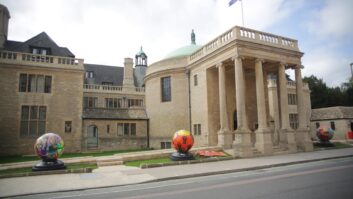
The influential Germany-based lighting designer and Scenario founder seeks to bring an “emotional approach” to installations – including the Ratskeller restaurant and bar/club in Saarbrücken, Germany (pictured). He talks to David Davies
How did you come to be working in professional AV, and what was it that particularly attracted you to scenographic lighting?
Working as a lighting consultant, I looked for possibilities to design spaces in a more sophisticated and detailed way than is possible with purely colour-dynamic light. Besides the purely technical lighting design, which aims to achieve standard values for good utility light, I love to shape spaces and rooms with light. In my projects, I not only place value on security, efficiency and visual task, but I also want people to feel comfortable due to the lighting. In short, I want to convey good feelings by an emotional approach through lighting.
How would you describe your own particular vision or concept for this kind of lighting?
My goal is to create ‘spaces for experience’ that increase or expand the character of the space through lighting. Immobile architecture should come alive! To give two examples, a quiescent area should really appeal to all senses and thereby create an almost meditative atmosphere, whilst a tunnel should lose its oppressive ambience so that a driver or pedestrian can concentrate on the traffic and his/her environment. There are, of course, lots of different approaches, but my aim is to give every space its own unmistakeable visual charm.
What was the starting point for your own company, Scenario, and when was it founded?
Scenario was founded in 1991, starting in the field of theatre, TV and show lighting. Subsequently, in the mid-90s, we moved into the area of architectural lighting design.
Given that development of the company’s interests, how do you decide upon the areas of the business that you want to explore and engage with?
The combination of utility lighting and emotionally-designed lighting creates a growing field of work for us. Our customers came to us with new challenges and interesting tasks, and so we expanded our portfolio to include the planning of control systems and multimedia networks, as well as the development of special fixtures for projects. In the creative field, we began to produce our own video content and music for sound installations in our own studio.
Which are the most important installation applications (eg. museums, theatres, conference centres, etc) for Scenario?
This may vary over the passage of time, but at the moment it is lighting design for shopping centres and the development of luminaires.
What do you regard as the greatest highlights of Scenario’s history to date?
There have been a lot of projects, so it’s difficult to make a selection! But the list of most significant projects would definitely include the Luis Barragán retrospective at the Instituto Valenciano de Arte Moderno in Spain, a temporary installation at the Vitra Museum Weil am Rhein in Germany, and – most recently – the Elms BMW Showrooms in Stansted and Bedford, UK.
What do you regard as the primary trends currently affecting the professional installed lighting sector?
One trend is to not only light places, but also use the light as a medium to communicate with people, which we do by using projected light in architectural applications. The second big trend is LED, which is becoming more interesting not only for accent lighting, but also for utility lighting. This obviously depends upon the visual task and the architectural environment in question, but the number of projects where LED is an alternative to other light sources has increased a lot recently.
Is there a recent project that illustrates some of these trends?
Yes – we recently created a lighting concept based on LED and video projectors for the Ratskeller Saarbrücken restaurant and bar/club in Germany. As part of this major project, we were required to integrate the new system with the existing lighting, ensure energy-efficiency and low service costs, and provide a strongly emotional impact.
How exactly did you go about achieving emotional resonance for this project?
The existing, warm white lights are dimmed to approximately 20%, depending on the time of the day, and complemented by an RGB LED fixture designed specifically for this space. The LED fixture was developed in such a way that it focuses exactly on the cross-vault, while the housing fits to the rest of the lighting systems used. We have also provided video projectors to decorate the cross-vault ceiling in the entrance hall with ‘living scenery’. For example, in the early evening, blazing torches light up the room with their warm light in a realistic way. Simultaneously, the LED fixtures colour the ceiling in the same colours generated from the video, thereby increasing the light intensity in the corresponding light mood. Meanwhile, LED cove lighting helps to develop the colour moods in the adjacent rooms.
The venue has lots of dramatic lighting scenes to work with, ranging from a fireplace scene to a dynamic night sky with star signs and comets’ tails. We have also provided scenes for the different seasons, while every evening at 10.30pm there is a fire spectacle entailing a specially-designed light show and music from [Carl Orff’s composition] ‘Carmina Burana’. It’s pretty impressive – breathtaking, in fact!
Control data for the different lighting scenes is stored and synchronised with the video content in a multimedia/DMX control system.
Finally, what does the future hold for Tobias Link? Any ambitions that you still want to realise?
I think that we live in a exciting time of change. On the one hand, we are forced to rethink a lot of things due to stronger ecological awareness and new legal regulations. On the other hand, there is a lot of potential in dealing with these issues, that – especially here in Europe – we can use and expand. In light planning and fixture design, we want to put value on these challenges. Personally speaking, it stimulates me to be upfront with these developments in order to help shape our world a bit and make our environment more pleasant and comfortable.







